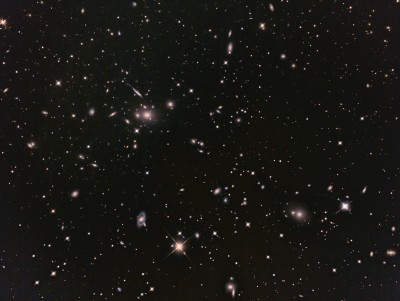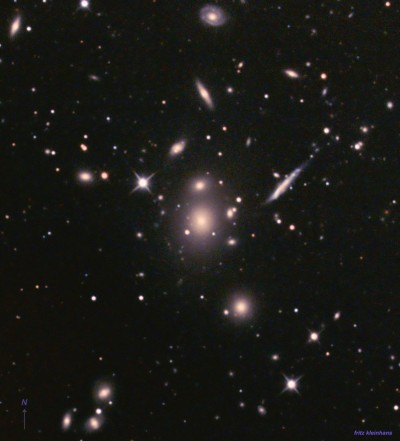
(fritz kleinhans)
Abell 1367
March 5/6, 2016, Chiefland, FL.
TAK 250 CDK with f/7.3 focal reducer; fl = 1825 mm.
Cooled, modified Hutech Canon 6D, ISO 800, 0.74 "/pixel.
(the scope only covers an APS-C chip, so with the full size 6D
chip there is a lot of vignetting around the field edge. The pic is
slightly cropped; 39.9' x 30.1')
Air ~ 44 F, Camera ~ -14 C
AP 1100 Mount, 50mm f/5 Borg Guidescope, Lodestar and PHD2, dithering.
7.5 min subs x 21 = 157.5 min (4 of 25 rejected)
21 lites, 5 darks, 3 flats; captured in BackYard EOS and processed in Images Plus and Picture
Window 7.
North is to the left. Below is a cropped and labeled
view of the area around the giant elliptical NGC 3842.
The noise and sky darkness is not uniform across the field. The noise
gradient is easy to understand, next paragraph.
TAK lists the image circle for this setup at 25 mm. Not
enough to cover the 24 x 36 mm chip. Thus there is
severe vignetting.
At the far edges the illumination is only ~ 61% of the center and in the corners
it is only 35% of the center.
Thus in moving from the center to the edge and corners of the frame, the
'stretching' and noise increases.
As for the non uniform darkness of the sky, I expect I need to do a better
job of flat fielding.
The picture definitely needs more work :). The mid and highlight tones seem
over stretched. Thus some of the small spirals seem over stretched and
have lost detail.
Abell 1367 field in Sky Tools Pro 3
(down to ~ m = 18)

Crop of the NGC 3842 region:
(rotated so north is up)
NGC 3842 region in negative B&W; from above.
Several galaxies are labeled and identified on the full size image at left.
Simbad and
NED were used for the identifications
and magnitudes. Simbad often lists
a blue and a red magnitude, and in that case I took the average for a visual
magnitude.
This photo easily goes down to m = 20 and contains many galaxies not indexed by
Simbad
and for which it was necessary to use NED. It can be hard to distinguish
galaxy from star
for the faintest objects. The SDSS9 photo, below, was used to verify this
distinction.
Sorry if there are any transcription errors. All those numbers make me
cross eyed!
Note that there are (at least) three Quasars in the picture; # 15, 19,
and 21. Check out
their colors in the color image above.
The two arrowed but unlabeled objects in UGC 6697 are background galaxies.
(Note: I have been using NED up
to now. I found Simbad much
easier and helpful for this type
of identification work. That said, NED had to be used to ID the faintest
galaxies and was used for #22 on.)
NGC 3842 Region
Composite of SDSS9 data downloaded from Simbad.
AP Home Kleinhans, 2024